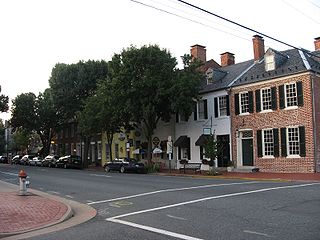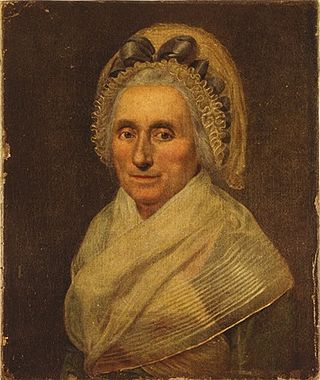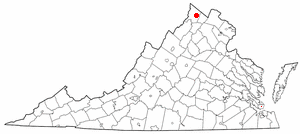
Fredericksburg is an independent city in Virginia, United States. As of the 2020 census, the population was 27,982. It is 48 miles (77 km) south of Washington, D.C., and 53 miles (85 km) north of Richmond. The Bureau of Economic Analysis of the United States Department of Commerce combines the city of Fredericksburg with neighboring Spotsylvania County for statistical purposes.

The George Washington Birthplace National Monument is a national monument in Westmoreland County, Virginia, at the confluence of Popes Creek and the Potomac River. It commemorates the birthplace location of George Washington, a Founding Father and the first President of the United States, who was born here on February 22, 1732. Washington lived at the residence until age three and later returned to live there as a teenager.

James Mercer was a Virginia lawyer, military officer, planter, jurist and politician.

Arlington House is the historic family residence of Robert E. Lee, commanding general of the Confederate Army during the American Civil War in Arlington County, Virginia. The estate of the historic home along with a memorial to Lee are now the center of Arlington National Cemetery in Arlington County, where they overlook the Potomac River and the National Mall in Washington, D.C.

Ferry Farm, also known as the George Washington Boyhood Home Site or the Ferry Farm Site, is the farm and home where George Washington spent much of his childhood. The site is located in Stafford County, Virginia, along the northern bank of the Rappahannock River, across from the city of Fredericksburg. In July 2008, archaeologists announced that they had found remains of the boyhood home, which had suffered a fire during 1740, including artifacts such as pieces of a cream-colored tea set probably belonging to George's mother, Mary Ball Washington. In 2015, the George Washington Foundation began constructing a replica of Washington's boyhood home on the site of the original building. The replica house was completed in 2018 and is open to the public.

Robert Brooke was a Virginia planter, soldier, lawyer, and politician who served as the tenth Governor of Virginia as well as in the Virginia House of Delegates, and as Attorney General of Virginia at the time of his death.

Buildings, sites, districts, and objects in Virginia listed on the National Register of Historic Places:

Fielding Lewis was an American merchant, member of the House of Burgesses and a Colonel during the American Revolutionary War. He lived in Fredericksburg, Virginia and also owned a plantation in Spotsylvania County, which later became known as Kenmore. His brother-in-law was George Washington, who was also his 2nd cousin, he was also 2nd cousins with Betty Washington.

Mary Ball Washington was an American planter best known for being the mother of the first president of the United States, George Washington. The second wife of Augustine Washington, she became a prominent member of the Washington family. She spent a large part of her life in Fredericksburg, Virginia, where several monuments were erected in her honor and a university, along with other public buildings, bear her name.

Red Hill Patrick Henry National Memorial, also known as Patrick Henry's Red Hill, in Charlotte County, Virginia, near the Town of Brookneal, is the final home and burial place of Founding Father Patrick Henry, the fiery legislator and orator of the American Revolution. Henry bought Red Hill Plantation at his retirement in 1794 and occupied it with his wife, Dorothea, and their children until 1799, the year of his death. In addition to the main house, Henry used another building as his law office. There were also dependencies and slave quarters on the working 2,930-acre tobacco plantation. The plantation was located on the Staunton River for transportation.

Highland, formerly Ash Lawn–Highland, located near Charlottesville, Virginia, United States, and adjacent to Thomas Jefferson's Monticello, was the estate of James Monroe, a Founding Father and fifth president of the United States. Purchased in 1793, Monroe and his family permanently settled on the property in 1799 and lived at Highland for twenty-five years. Personal debt forced Monroe to sell the plantation in 1825. Before and after selling Highland, Monroe spent much of his time living at the plantation house at his large Oak Hill estate near Leesburg, Virginia.

James Breckinridge was a Virginia lawyer and politician and a member of the Breckinridge family. He served in the Virginia House of Delegates, as well as the U.S. House of Representatives. He also fought in the American Revolutionary War and served as a brigadier-general during the War of 1812.

The Mary Washington House, at 1200 Charles Street in Fredericksburg, Virginia, is the house in which George Washington's mother, Mary Ball Washington, resided towards the end of her life. It is now operated as an 18th-century period historic house museum, one of several museums in Fredericksburg operated by Washington Heritage Museums. Today it displays 18th-century furniture, and her personal possessions, such as her "best dressing glass”.

Kenmore, also known as Kenmore Plantation, is a plantation house at 1201 Washington Avenue in Fredericksburg, Virginia. Built in the 1770s, it was the home of Fielding and Betty Washington Lewis and is the only surviving structure from the 1,300-acre (530 ha) Kenmore plantation.

The John Marshall House is a historic house museum and National Historic Landmark at 818 East Marshall Street in Richmond, Virginia. It was the home of Chief Justice of the United States and Founding Father John Marshall, who was appointed to the court in 1801 by President John Adams and served for the rest of his life, writing such influential decisions as Marbury v. Madison (1803) and McCulloch v. Maryland (1819).

The Rising Sun Tavern is a historic building in Fredericksburg, Virginia. It was built in about 1760 as a home by Charles Washington, youngest brother of George Washington, and became a tavern in 1792.

The Woodrow Wilson Boyhood Home is a historic house museum at 419 7th Street in Augusta, Georgia. Built in 1859, it was a childhood home of Woodrow Wilson (1856–1924), the 28th president of the United States and proponent of the League of Nations. The house is owned and operated by Historic Augusta, Inc., and was designated a National Historic Landmark on October 6, 2008.

This is a list of the National Register of Historic Places listings in Winchester, Virginia.

The Chimneys is a historic house located in Fredericksburg, Virginia. The house was constructed around 1771–1773. The house is named because of the stone chimneys at each end. The Georgian home was added to the National Register of Historic Places in April 1975. Of note are the interior decorative woodwork in the moldings, millwork, paneling indicative of building styles of the period. The decorative carving on the mantelpiece as well as on the door and window frames is particularly significant.

James Monroe Birthplace Park & Museum, also known as James Monroe's Birthplace, is a historic archaeological site located near Oak Grove and Colonial Beach, Westmoreland County, Virginia. The site includes the ruins and a restoration of the Monroe Family Home and birthplace of U.S. Founding Father and President James Monroe, which were uncovered in 1976 by a team from the College of William & Mary. Monroe spent his entire youth working the farm until he left for his education at William & Mary, following which he served in the Continental Army. The archaeological team uncovered a house foundation measuring 20 feet by 58 feet. The known 1845 etchings of the birth home indicate a small four room, rough cut wooden farm house with few outbuildings on a 500-acre farm filled with wetlands.



























